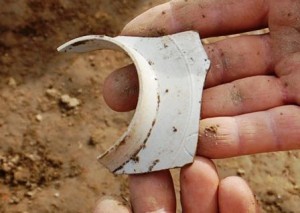

Facebook Twitter Flickr YouTube RSS Feed
Written on: March 7th, 2013 in Archaeology Updates, US301
The lab at Dovetail has been very busy this month working through the large Houston-LeCompt collection. To date all of Phase I artifacts are washed and we have started cleaning Phase II materials and continue cataloging the Phase III collection. It was this process that spawned the idea of participating in the ‘Small Finds’ session at the Mid-Atlantic Archaeology Conference (MAAC) this weekend. Among the thousands of artifacts recovered from the Houston-LeCompt site were ornate, hand-painted buttons, brass furniture plates, handmade jewelry, and exquisite decorative ceramics. These items were perhaps owned by the first inhabitants of the site during the second half of the eighteenth century. One person associated with this site is Mary Houston, a widow who seemed to enjoy the finer things in life. When Mary’s descendants bought the land back around 1900, once again the quantity of personal artifacts was represented in the artifact assemblage. These elaborate items as well as some day-to-day personal effects such as toothbrushes, coins, shoes, and thimbles, will be part of a larger symposium that celebrates the ‘small finds’ of an archaeological collection. It is often these smaller items that reveal the most interesting information on the personalities of the occupants of a site.
Written on: March 7th, 2013 in Archaeology Updates, US301

Sometimes you wind up the fieldwork on an archaeological site with firm ideas about what you found, then get into the lab, look over your artifacts and change your mind. Work on an archaeological site is never really finished. Even when the original excavators are dead, somebody may decide to go through the notes and artifacts again and come up with new interpretations. After our first round of testing at Noxon’s Tenancy, we thought the site had a very short occupation. There weren’t very many artifacts in the plowzone, and they all seemed to date to around 1750. So we thought the site might have been occupied for a decade, say 1745 to 1755.
During the excavation we slowly changed our minds. The site has two wells, one used after the other had been abandoned, which seems to suggest a longer occupation that just ten years. We also found more artifacts than we expected. So when we left the field we were thinking in terms of twenty years, say 1740 to 1760.
As the artifacts are cleaned and cataloged we are changing our ideas even more. Several small artifacts have turned up that were made before 1740, and since colonial Delawareans did not usually carry many dishes with them to a new farm site, these artifacts may be telling us that the site is older than we thought. Several sherds of a kind of pottery called “scratch brown” stoneware have been found, probably made between 1720 and 1735. A single sherd of an even older type, buff-bodied earthenware with yellow glaze, has also been identified, and this was probably made before 1725. These few objects are not much to go on, but analysis of the finds is just getting under way. Since we still think the site was abandoned around 1760, it may have been occupied for thirty years or longer. Right now we would date the site to 1730 to 1760, but then again, we still have a lot of work to do.
Written on: March 7th, 2013 in Archaeology Updates, US301
The Route 301 archaeological project is abuzz with excitement this week as numerous archaeologists, including Michael Gall and Ilene Grossman-Bailey of Richard Grubb & Associates, prepare presentations for this week’s Middle Atlantic Archaeological Conference in Virginia Beach, Virginia. Michael and Ilene’s presentation will focus on archaeological excavations at the Rumsey/Polk Tenant/Prehistoric Site an 18th-century settlement along the Sandy Branch in St. Georges Hundred. We’re all expecting a great turnout for a fantastic set of presentations on Delaware archaeology. More news will be reported on the event in April’s blog.
As a result of the archaeological excavations at the Rumsey/Polk Tenant/Prehistoric Site, Richard Grubb & Associates recovered over 25,000 artifacts! It’s an amazing collection indeed. The collection contains broken dishes, bottle glass, clothing items, utensils, and LOTS of animal bones from food the former residents ate. Artifacts range from very big to tiny. Some of the artifacts are so small that excavated soil has to be water screened in order to collect fish bones, fish scales, egg shell, charcoal, and plant seeds, after which time the tiny artifacts are collected. Such artifacts provide a wealth of information about the types of foods eaten by residents in 18th-century Delaware. Once all of the artifacts are cleaned in the coming months, we expect to learn a lot more about the site’s former occupants.
Written on: February 19th, 2013 in Route 26
In an effort to facilitate ongoing overhead utility relocations, DelDOT has modified the restrictions on lane closures during the peak season for SR26. The peak season begins May 15 and ends September 30. Lane closures during the peak season would normally be restricted to the hours between 9 a.m. and 3 p.m., Monday through Friday.
DelDOT has modified the hours during which lanes can be closed on SR26. During the off-peak season, lane closures are permitted from 9 a.m. to dusk. These hours will remain in effect through June 30, 2013. From July 1, 2013 to September 30, 2013 lane closures will be restricted to the hours between 7 p.m. and 6 a.m., Monday through Friday morning.
Lane closures will not be allowed on Holidays and Weekends. DelDOT will monitor the impacts of lane closures and maintains the rights to modify the time restrictions based off of delays.
Written on: February 6th, 2013 in Archaeology Updates, US301
Brrr…. It’s cold outside but but sometimes archaeologists must work through the winter to help keep tight project schedules. We still have to get the work done even if we “turn into snowmen.” Work on Route 301 archaeology at Rumsey/Polk site has taken some ingenuity including bundling up really well, the use of thermal liners for our one-meter square excavation units, the use of protective shelters, and a trailer for storing our equipment. The thermal pads covering our excavation units worked very well to keep the ground where we planned to work from freezing despite snow all around us. So stay warm thinking about all that we are learning from our winter work. RGA archaeologists Mike Gall and Ilene Grossman-Bailey are working hard to get our presentation on the results of the Phase III Data Recovery at the Rumsey/Polk site ready for next month’s Middle Atlantic Archaeological Conference in Virginia Beach. We’ll be reporting on our 622 cultural features- posts, pits, earthfast houses, and a ten-meter deep well- and over 12,000 artifacts of all types from the two periods when people lived at the site – 1740s-1770s and circa 1800-1855. Hope to see you there!
Written on: February 5th, 2013 in Archaeology Updates, US301
At the end of every archaeological field project comes a long list of chores: the site has to be cleaned up and backfilled, the artifacts all have to be packed up and delivered to the lab, the photographs downloaded from the camera, the photo log digitized, the equipment cleaned and stored. For the 301 project there are other tasks to be done, such as taking these final photos and measuring the archaeological area so the farmer can be compensated for the crops we impacted. Only when all of this housekeeping is taken care of can we move on to the next stage of the project, analyzing the artifacts and preparing the report. Once the artifacts reach the lab, they have to be checked in, and the list of stuff that reached the lab checked against the catalog made in the field. Then they are washed and dried. Meanwhile, special materials are sorted out and sent to the experts who will process them: some soil samples are sent to the ethnobotanist, who will float them in water to separate out charcoal, charred seeds and other organic remains; others are sent to a lab for chemical analysis. We are all excited about the stuff we brought back from the Noxon Tenancy site, because there are so many fascinating artifacts, and so many pots we ought to be able to put back together.
Written on: February 5th, 2013 in Archaeology Updates, US301
For the past month Hunter Research has been busy in the lab processing dozens of soil floatation samples, entering information into databases and preparing graphics and End of Fieldwork Summaries for the Cardon-Holton historic site 7NC-F- 128 and the Elkins sites 7NC-G-174. These sites were evidently not occupied for an extended periods of time and may represent examples of what are termed “contract plantations”. Contract plantation arrangements were recorded in Articles of Agreement, whereby one or more individuals contracted with a plantation owner for a short, set period of years (5 and 7 being the most common), chiefly to clear woodland and establish viable livestock herds and orchards. Profits from these items would be shared between the contractor and the owner, and the contractor could also profit independently from crops. Those engaged in such a contract would be motivated to keep the number of improvements to a bare minimum, making capital investments in only what was necessary to make the property viable for a short period of years. The limited number of substantial features (i.e. features other than postholes), and the artifact assemblages at the Cardon/Holton and Elkins sites indicate short-term occupations.
Flotation conducted from the Elkins B site cellar hole continues to produce glass trade seed beads (round and tube), scales, straight, pins, egg shell, fish scales, small lead shot, daub, bits of gunflints, small animal bones, charcoal and small land snails. Land snails are important indicators of past environmental conditions. Another artifact type of note is the freshwater mussel. Freshwater mussels (Elliptio complanata) are typically found on Native American sites, and as a rule were not consumed by Europeans during the 18th century in the east. Mussels are an ingredient of a nutritious Native American food known as pemmican, a concentrated mixture of fat and protein, which was widely adopted as a high-energy food by Europeans involved in the fur trade west of the Appalachian Chain. Glass trade beads and freshwater mussels suggests the possibility of a Native American presence or at very least interaction with the inhabitants of the site.
The circular feature thought to be a possible wolf pit (trap) contained 263 tabular slabs of sedimentary stone weighing 202.5 pounds that were mainly located in the center of the feature fill. These slabs were resting in a vertical position. Cross-mending of the slabs revealed they may have originated from a single slab. These sedimentary stone slabs contained numerous fossils and according to David Parris, Curator of Natural History at the New Jersey State Museum, the fossils are the impressions of Crinoidea columnals (Order Echinodermata) and Mucrosphirifer mucronatus, a brachiopod shell (also known as butterfly shells) from the Middle Devonian strata of the Hamilton Group of New York (with equivalents elsewhere in the Appalachian chain).
Continued research on this feature, including examination of ethnographic accounts of Native American wolf pits in the 19th century American West, now suggests quite strongly that this is indeed a wolf pit, perhaps from the late 17th or early 18th century, possibly dug and used by Indians. The colonial authorities were very concerned to eradicate wolves in this time period, encouraging and requiring the digging of wolf pits or trap houses, and Indians are recorded to have been paid for wolf pelts. If our interpretation is correct, this is a remarkable example of cultural interaction in the early decades of Colonial Delaware.
Written on: February 5th, 2013 in Archaeology Updates, US301
During Dovetail’s 2012 summer excavation of the Houston-LeCompt site, 3 wells were uncovered and explored. The wells span the occupation of the site with the first dating to pre-1800, the second to 1800–1865, and the third to 1900–1930s. Initial excavation involved a systematic approach with shovels and trowels. Once sufficient data was collected, a backhoe was brought in at the end of the project to bi-sect the wells in their entirety. Each well contained interior structures buried below the water table consisting of posts and planks hewn from yellow hard pine and white oak. Dovetail retained 14 samples from the wells for temporary conservation. Wood samples were photographed in the field and after the initial cleaning process. Measurements including length, width, and thickness were recorded as well as any defining characteristics (i.e. hewn post, nails present, or fastener holes). The wood is cleaned by hand weekly and resubmerged in clean water. Given the size of a few of the posts and their shape, Dovetail purchased a fiberglass bathtub to accommodate the larger wood samples. While plans for final curation have yet to be determined, it is likely that some of the more representative pieces with be retained and sent to the Maryland Archaeological Conservation Laboratory for final conservation.
Written on: January 28th, 2013 in Route 26
The SR26 Project Team held its second construction working group meeting at 10:00 a. m. on January 28, 2013. DelDOT Secretary Shailen Bhatt was in attendance as well as the newly elected State Representative Ron Gray, along with representatives from Verizon and Delmarva Power and the rest of the working group. The meeting included a review of SR26 Detour Routes, updates on utility relocation and tree clearing for the SR26 Mainline, and a discussion of work hours and restrictions for the project. A powerpoint presentation was given as well, which is available for viewing on the project website along with the meeting agenda and project displays.